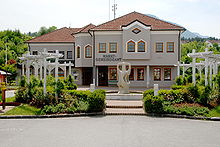Feistritz im Rosental
Feistritz im Rosental | |
|---|---|
 St John parish church | |
| Coordinates: 46°31′N 14°10′E / 46.517°N 14.167°E | |
| Country | Austria |
| State | Carinthia |
| District | Klagenfurt-Land |
| Government | |
| • Mayor | Sonya Feinig (SPÖ) |
| Area | |
| • Total | 71.73 km2 (27.70 sq mi) |
| Elevation | 549 m (1,801 ft) |
| Population (2018-01-01)[2] | |
| • Total | 2,506 |
| • Density | 35/km2 (90/sq mi) |
| Time zone | UTC+1 (CET) |
| • Summer (DST) | UTC+2 (CEST) |
| Postal code | 9181 |
| Area code | 04228 |
| Website | www.rosengemeinde.at |
Feistritz im Rosental (Slovene: Bistrica v Rožu) is a market town in the district of Klagenfurt-Land in the Austrian state of Carinthia.
Geography

It is located in the Rosental, the U-shaped valley of the Drava river north of the Karawanks mountain range along the Periadriatic Seam. The valley is named after the Carinthian noble house of Ras, who had Rosegg Castle built around 1200. It is a traditional settlement area of Carinthian Slovenes. The Karawanks in the south form the border with Upper Carniola.
The municipal area stretches from the Drava and neighbouring Ludmannsdorf beyond the river up to Mt. Stol (Hochstuhl), the highest peak of the Karawanks range at 2,236 m (7,336 ft) which can be reached via the Bärental (Rute) high valley. It comprises the cadastral communities of Feistritz (Bistrica), Gansdorf, Hundsdorf (Podsinja vas), Matschach (Mače), Suetschach (Sveče), and Weizelsdorf (Svetna vas).
History

Feistritz was a historic site of iron ore processing at least since the 16th century. The Bärental mines later supplied the raw material for the production of steel wire used for telegraphy. During the early stages of industrialisation, a large rolling mill was founded in 1840. It was replaced as main employer by a battery manufacturing site (Bären-Batterie) in 1938, until the production was shut down in 1998.
The present-day municipality was established in 1850, at first called Suetschach. It merged with neighbouring Weizelsdorf in 1973 and received the status of a market town in 1996.
In the Carinthian Plebiscite of 1920, Sankt Jakob was one of the 17 Carinthian municipalities, where the majority of the population (55%) voted for the annexation by the Kingdom of Serbs, Croats and Slovenes (Yugoslavia).
Population
According to the 2001 census 13.3% of the population are Carinthian Slovenes. The municipality is made up of eight villages:
| Village | Number of people 1991 | Percent of Slovenes 1991 | Percent of Slovenes 1951 |
|---|---|---|---|
| Hundsdorf / Podsinja vas | 157 | 14.6% | 81.5% |
| St.Johann i.R. / Šentjanž v R. | 279 | 42.3% | 84.5% |
| Matschach/Mače | 114 | 16.7% | 77.5% |
| Suetschach/Sveče | 574 | 13.4% | 57.7% |
| Rabenberg / Šentjanške Rute | 24 | 45.8% | 92.5% |
| Feistritz i R. / Bistrica v Rožu | 1054 | 6.7% | 16.4% |
| Bärental/Zavrh | 21 | 0% | 77.3% |
| Weizelsdorf / Svetna vas | 323 | 5.3% | 45.4% |
Politics

Seats in the municipal assembly (Gemeinderat) as of 2015 local elections:
- Social Democratic Party of Austria (SPÖ): 12
- Freedom Party of Austria (FPÖ): 3
- Unity List (Enotna lista): 2
- Austrian People's Party (ÖVP): 2
Notable people
Notable natives of Feistritz include the Slovene politician and editor Andrej Einspieler (1813-1888) and the diplomat Valentin Inzko (born 1949), who was born in Suetschach, where he lives with his wife Bernarda Fink (b. 1955). The Nordic skier Tomaz Druml (b. 1988) was also born in Feistritz.
The sculptor France Gorše (1897-1986), a native from Zamostec, lived in the village of Suetschach, where he established an artist's studio in 1974, now open to the public. Also the politician and former Carinthian governor Jörg Haider (1950-2008) lived in Bärental.
References
- ^ "Dauersiedlungsraum der Gemeinden Politischen Bezirke und Bundesländer - Gebietsstand 1.1.2018". Statistics Austria. Retrieved 10 March 2019.
- ^ "Einwohnerzahl 1.1.2018 nach Gemeinden mit Status, Gebietsstand 1.1.2018". Statistics Austria. Retrieved 9 March 2019.


